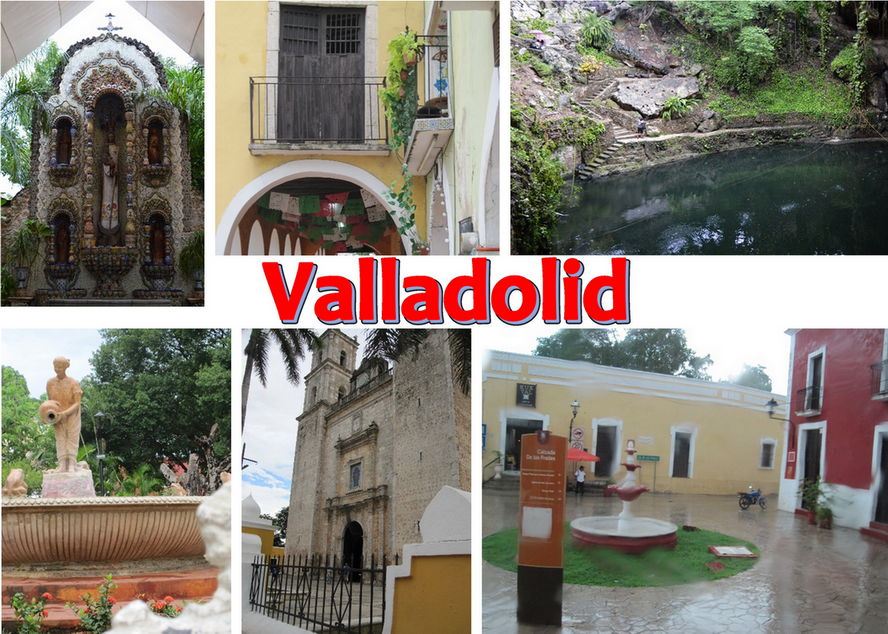The village of Valladolid with its colorful houses offers a serene and lively atmosphere alongside the historic gray stone structures. The light rain did not tarnish our passage but on the contrary, the rain actually enhanced the colors.
The village receives thousands of visiting tourists every year who return from an organized getaway to one of the popular sites in the surrounding area which includes that of Chichen Itza. Coaches stop in Valladolid for visitors to explore, refuel and admire. As passing tourists, we weren’t prepared enough to walk around and missed opportunities. Anyway, let’s hope that it doesn’t happen to you.
During our quick stop in town, we noticed:
- The colorful streets
- Francisco Canton Rosado center park with the fountain
- Fountain in Parque Francisco Canton
- Cathedral San Servacio or Gervasio
- Cenote Zaci
But know that we missed:
- Convent of San Bernardino de Siena
- Museums
Before saying more about this beautiful discovery, it is always interesting to know the history of the place. As strange as it may seem, Valladolid is a displaced village. Founded in 1543 by a Spaniard, the disturbing presence of mosquitoes brought its share of discomfort to a place named in honor of the former capital of Spain, so it was decided to move the village. A new location was found, but selfishly at the expense of an already established Mayan community. Not without clashes, in 1545 the Mayan buildings that stood there were demolished and the stones were moved and used to rebuild the new Spanish city.
For good reason, the frustration of the Mayan community was high. In addition, the Convent of San Bernardino was built a few years later and is still standing today, to convert the population to Christianity. Time passes, but the feeling of exclusion and of repression remains palpable among the Mayans. Until 1705, new murderous revolts took place. Several Spanish officials took refuge in the cathedral. The cathedral lost its glory in the community and was demolished to rebuild the one currently in the central square.
Today, there is a better understanding between the communities and the Mayans are recognized there.
The colorful streets
This will probably be your first sighting. The charm of its streets, its cheerfully colored houses, the sparkling souvenir or art shops and the culinary offerings behind a facade magically show interior courtyards enhanced with fountains or sculptures, all with passionate people who welcome us.
Wandering the streets and visiting the shops/museums is a pleasant local experience. All of your senses will at one time or another be called upon to participate.
Main Park Francisco Canton Rosado
Right in the center of the village, the main park is a gathering place where you may witness a traditional dance demonstration. Otherwise, the fountain in its center will potentially enhance your visit. Benches lead to laziness and to admire the people passing by.
Catedral de San Servasio / Cathedral of San Servacio / Iglesia de San Servicio ou San Gervasio
Facing the main park is the Cathedral of San Servasio. As mentioned previously, here the story is overwhelming. The Spaniards, having conquered the territory, upset the rituals. They chose to build a church directly on a Mayan pyramid.
In front of you is the second cathedral on the site. The first and the one that protected Spanish officials during the Maya rebellion of 1704 was demolished by its association. The one you can visit was quickly built the following year with some stones from the building of the original religious site, which gives it a certain personality.
The interior is simple, without extravagant decoration, but where my gaze was directed towards the wrought iron of the doors and windows, the lighting descending from the dome and the welcoming statuette halfway up the aisle.
Cenote Zaci
Cenotes are common in the region. These are cool groundwaters, usually below ground level and often partially hidden in caves.
The Cenote Zaci de Valladolid offers fresh, calm, open water, surprisingly cool and shaded. The view is beautiful and accessed by a carved stone staircase. The environment is not claustrophobic as the cavern is partially collapsed.
We felt like we were away from the city. It was a short stop. It is possible to swim there, but no one had an interest in our group. Maybe the fact that there were no changing rooms had an impact.
It is typical to access these sites via a series of vendors/artisans selling handicrafts. This place is no exception.
Zaci would be the name of the Mayan village before being razed to build Valladolid there.
Convent of San Bernardino de Siena
The convent was built by Franciscan missionaries between 1552 and 1560. It is about ten-minute walk from the square. The walls of this establishment have seen a lot over the years and not always pleasant I presume. It was a place of conversion to Christianity in the village.
For all my posts on Mexico click here.

